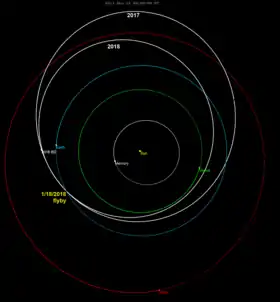2018 BD
2018 BD is a small asteroid and near-Earth object of the Apollo group, approximately 2–6 meters (7–20 ft) in diameter. It was first observed on 18 January 2018, by astronomers of the Catalina Sky Survey at Mount Lemmon Observatory, Arizona, United States,[1] just hours before passing about 0.10 lunar distances of the Earth.[2]
 Orbit before and after 1/18/2018 flyby | |
| Discovery [1] | |
|---|---|
| Discovered by | CSS |
| Discovery site | Mount Lemmon Obs. |
| Discovery date | 18 January 2018 (first observed only) |
| Designations | |
| 2018 BD | |
| NEO · Apollo [1][2] | |
| Orbital characteristics [2] | |
| Epoch 23 March 2018 (JD 2458200.5) | |
| Uncertainty parameter 7 | |
| Observation arc | 1 day |
| Aphelion | 1.3555 AU |
| Perihelion | 0.7508 AU |
| 1.0531 AU | |
| Eccentricity | 0.2871 |
| 1.08 yr (395 days) | |
| 357.05° | |
| 0° 54m 43.2s / day | |
| Inclination | 2.4082° |
| 298.10° | |
| 273.70° | |
| Earth MOID | 6.019×10−6 AU (0.00234 LD) |
| Physical characteristics | |
Mean diameter | 2 m (est. at 0.35)[3] 6 m (est. at 0.05)[3] |
| 30.154[2] | |
Orbit and classification
2018 BD is an Apollo asteroid. It orbits the Sun at a distance of 0.75–1.36 AU once every 13 months (395 days; semi-major axis of 1.05 AU). Its orbit has an eccentricity of 0.29 and an inclination of 2° with respect to the ecliptic.[2]
The object has an exceptionally low minimum orbital intersection distance with Earth of 900 km; 560 mi (0.000006019 AU), or 0.002 lunar distances.[2]
2018 approach


Physical characteristics
Based on a generic magnitude-to-diameter conversion, 2018 BD measures between 2 and 6 meters in diameter, for an absolute magnitude of 30.154, and an assumed albedo between 0.05 and 0.20, which represent typical values for carbonaceous and a bright E-type asteroids, respectively.[3] As of 2018, no rotational lightcurve of this object has been obtained from photometric observations. The body's rotation period, pole and shape remain unknown.[2]
Numbering and naming
This minor planet has neither been numbered nor named.[1]
References
- "2018 BD". Minor Planet Center. Retrieved 22 February 2018.
- "JPL Small-Body Database Browser: (2018 BD)" (2018-01-18 last obs.). Jet Propulsion Laboratory. Retrieved 22 February 2018.
- "Asteroid Size Estimator". CNEOS NASA/JPL. Retrieved 22 February 2018.
External links
- Flyby diagram of 2018 BD, Minor Planet Center
- Asteroid 2018 BD missed Earth by just 0.10 LD on January 18, The Watchers, 18 January 2018
- A new asteroid was discovered just seven hours before cruising past Earth, BGR.com, 19 January 2018
- 2018 BD at NeoDyS-2, Near Earth Objects—Dynamic Site
- Ephemeris · Obs prediction · Orbital info · MOID · Proper elements · Obs info · Close · Physical info · NEOCC
- 2018 BD at the JPL Small-Body Database

